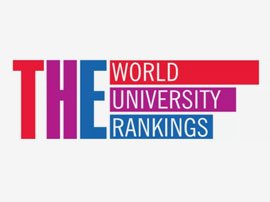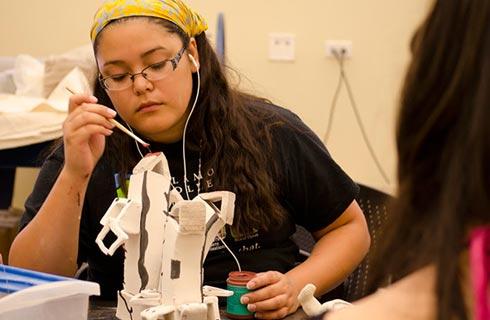艺术美术硕士-平面设计
Master of Fine Arts in Art - Graphic Design

学历文凭
Masters Degree

专业院系
College of Communication and Fine Arts

开学时间

课程时长

课程学费

国际学生入学条件
Baccalaureate Degree: The applicant must provide an official transcript showing that a bachelor’s degree was awarded by an accredited college or university. If you are a UofM undergraduate student applying to Graduate School at UofM, you do not need to request that an official transcript be sent to Graduate Admissions. This office has access to your transcript. In addition, transcripts from any other college or university attended may be requested. Only transcripts received directly from an issuing institution are considered official. Personal copies are not acceptable as official documents.
GPA: The applicant must have earned an acceptable grade point average, typically a minimum of 2.5 on a scale of 4.0, but departments may make exceptions for students whose overall GPA does not adequately reflect their ability to succeed in their chosen field.
English proficiency test scores accepted by the University:
- Duolingo English Test-110 or higher on the overall score.
- TOEFL (Test of English as a Foreign Language) 550 or higher on the paper version, 80 or higher on the internet-based test
- IELTS (International English Language Testing System)- 6.5 or higher
- PTE (Pearson Test of English) - 59 or higher
IDP—雅思考试联合主办方

雅思考试总分
6.0
- 雅思总分:6
- 托福网考总分:79
- 托福笔试总分:550
- 其他语言考试:PTE (Pearson Test of English) - 53 or higher
CRICOS代码:
申请截止日期: 请与IDP联系 以获取详细信息。
课程简介
In the graphic design concentration, students focus on advancing their skills, knowledge, and critical thinking in the field of graphic design. Building upon their undergraduate foundation, students delve deeper into design theory, research, and practical application. The program encourages students to explore innovative approaches, push the boundaries of design, and develop a unique design voice.<br><br>Students engage in advanced coursework that emphasizes conceptual thinking, design strategy, and design research methodologies. They delve into complex design problems, exploring how design can address social, cultural, and environmental issues. Through rigorous analysis and critical evaluation, students learn to develop design solutions that are not only visually appealing but also conceptually strong and effective in communication.<br><br>Advanced design software and digital tools are integral to the program, enabling students to refine their technical skills and explore the latest trends and technologies in graphic design. They learn advanced techniques in areas such as typography, branding, information design, interactive design, motion graphics, and user experience design. They also study design systems and methodologies to develop coherent and consistent visual identities across various platforms and media.<br>Collaborative projects and interdisciplinary approaches are incorporated into the program, allowing students to work with peers from different disciplines and engage in real-world design challenges. These experiences foster teamwork, communication, and adaptability, preparing students for collaborative design environments and interdisciplinary design practices.<br><br>In addition to studio work, the graphic design program includes research components. Students engage in design research, exploring theoretical frameworks, design history, and critical analysis. They develop skills in conducting research, gathering data, and applying research findings to inform their design practice.<br><br>The program also emphasizes the development of a comprehensive design portfolio that showcases the students' best work and demonstrates their design process, problem-solving abilities, and creative vision. Faculty mentorship and critiques provide guidance and feedback to refine and elevate their design work.
相关申请
 预科
预科 奖学金
奖学金 实习机会
实习机会 在校学习
在校学习 跨境学习
跨境学习 校园授课-线上开始
校园授课-线上开始 在线/远程学习
在线/远程学习
开学时间&学费
学费信息仅供参考,请与IDP联系以获取详细信息
| 开学时间 | 时长 | 学费 | 地点 |
|---|
本校相关课程
其他相关课程

艺术学士-计划一(视觉研究)-艺术写作与批评
 加州州立大学圣贝纳迪诺分校
加州州立大学圣贝纳迪诺分校学历文凭
Bachelor Degree
开学日期
课程费用总额


戏剧艺术美术硕士-舞台管理
 爱荷华大学
爱荷华大学泰晤士高等教育世界大学排名:342
学历文凭
Masters Degree
开学日期
课程费用总额


Bachelor of Arts in International Literary and Visual Studies
 塔夫茨大学
塔夫茨大学泰晤士高等教育世界大学排名:189
学历文凭
Bachelor Degree
开学日期
课程费用总额


Bachelor of Arts in Visual Arts and Bachelor of Education [Concurrent] with Thesis Honours
 温莎大学
温莎大学学历文凭
Bachelor Degree with Honours
开学日期
课程费用总额


Bachelor of Arts in Theatre and Performing Arts
 爱荷华州立大学
爱荷华州立大学泰晤士高等教育世界大学排名:431
学历文凭
Bachelor Degree
开学日期
课程费用总额


表演艺术基金会证书
 荷兰学院
荷兰学院学历文凭
Bachelor Degree
开学日期
课程费用总额

















